
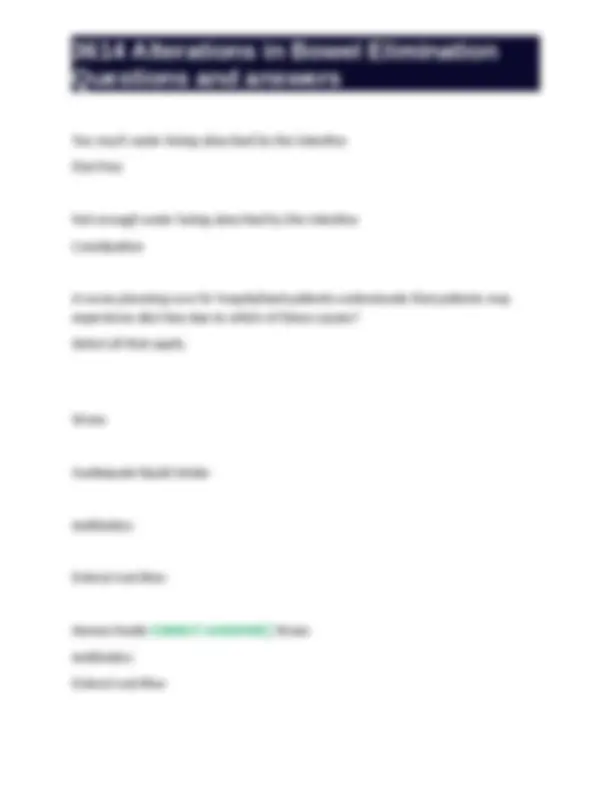
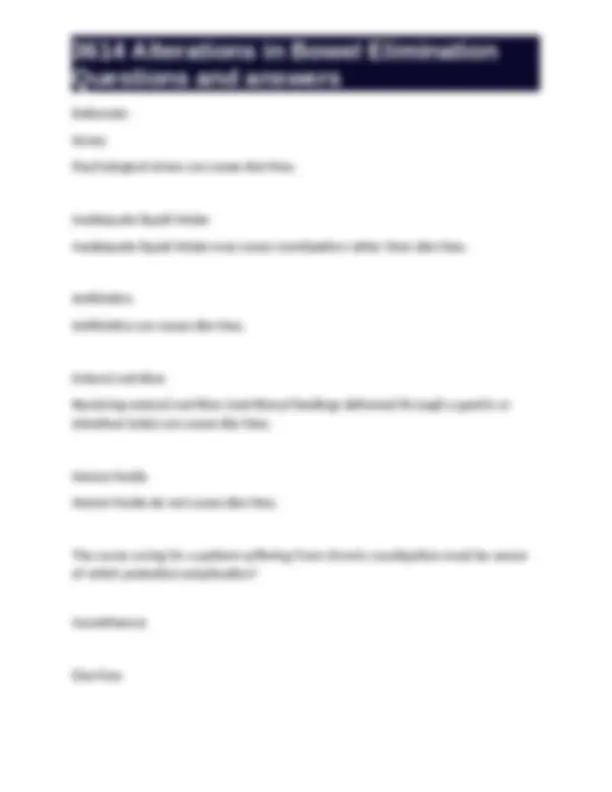
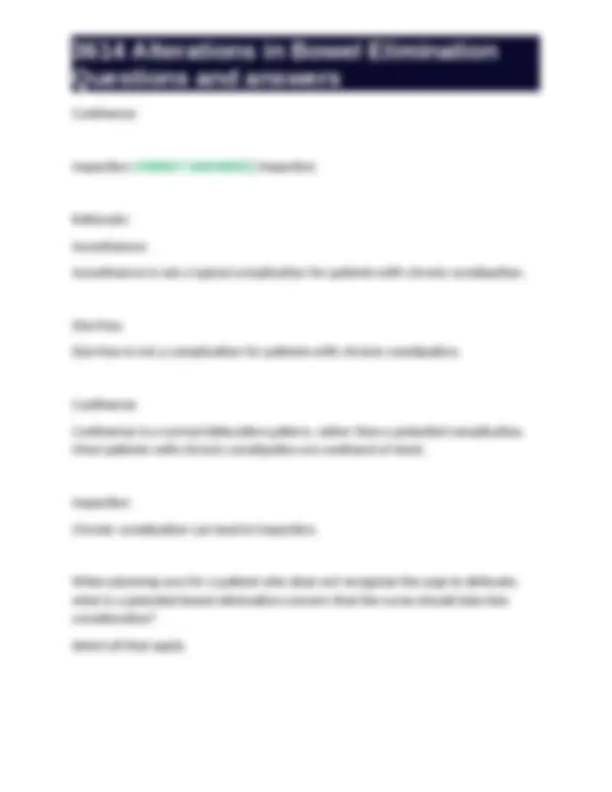
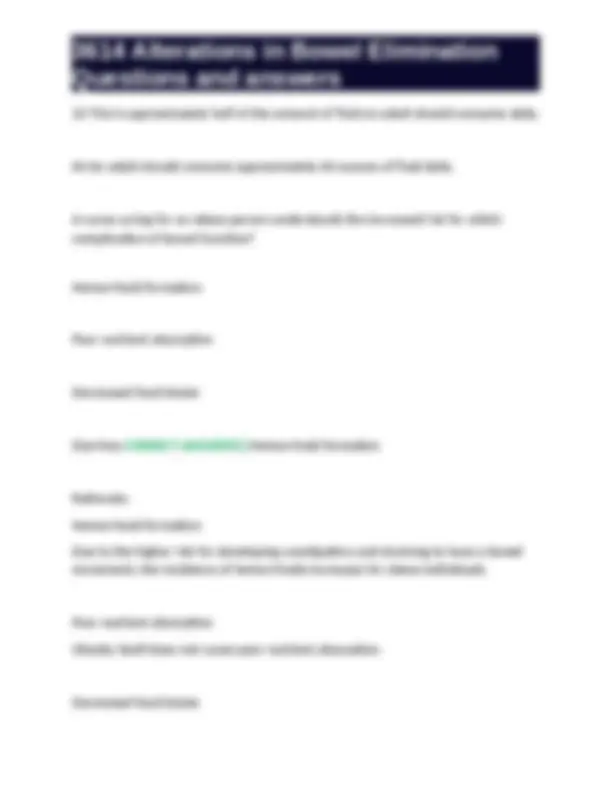
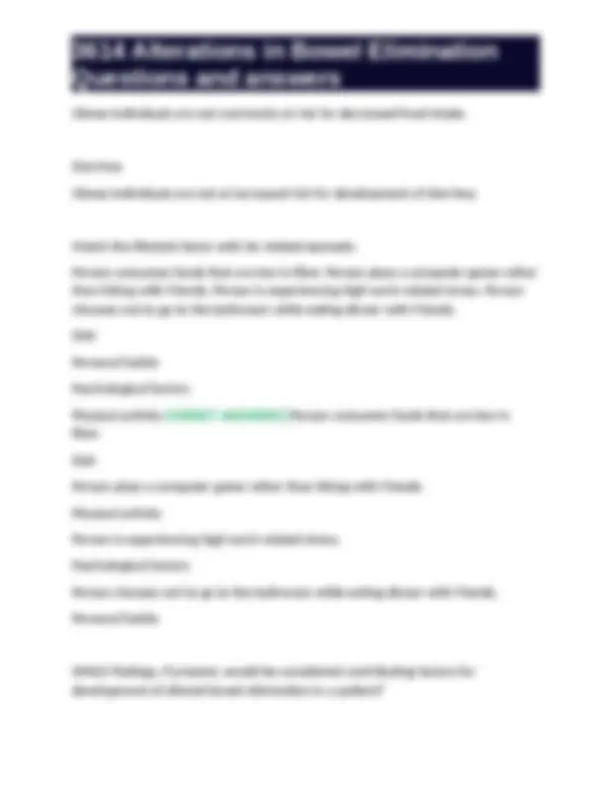
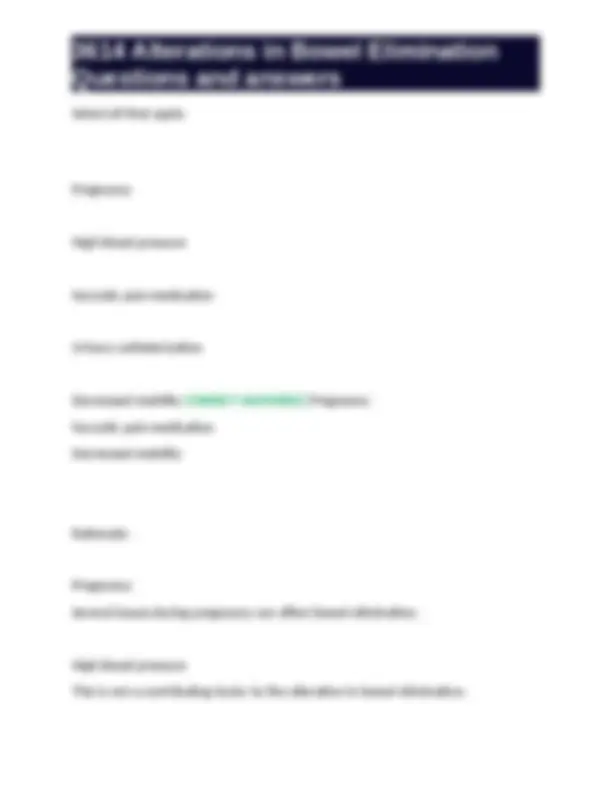
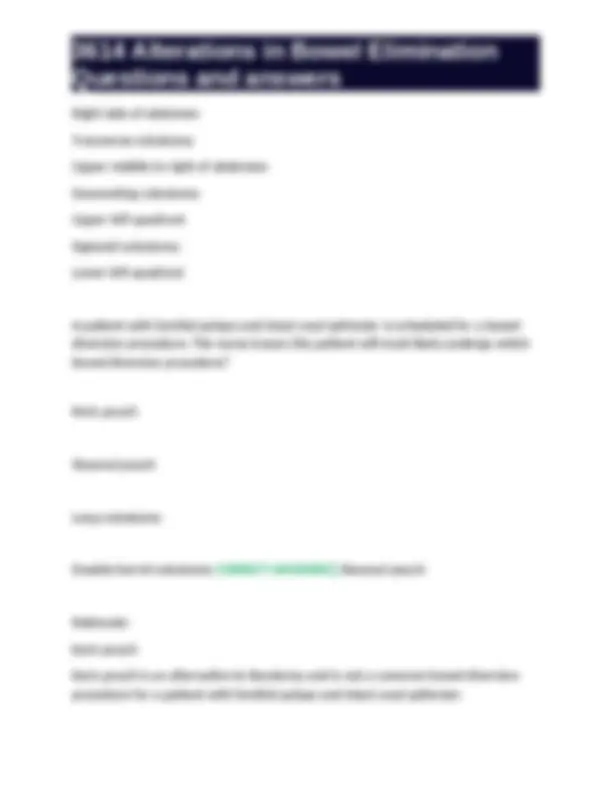
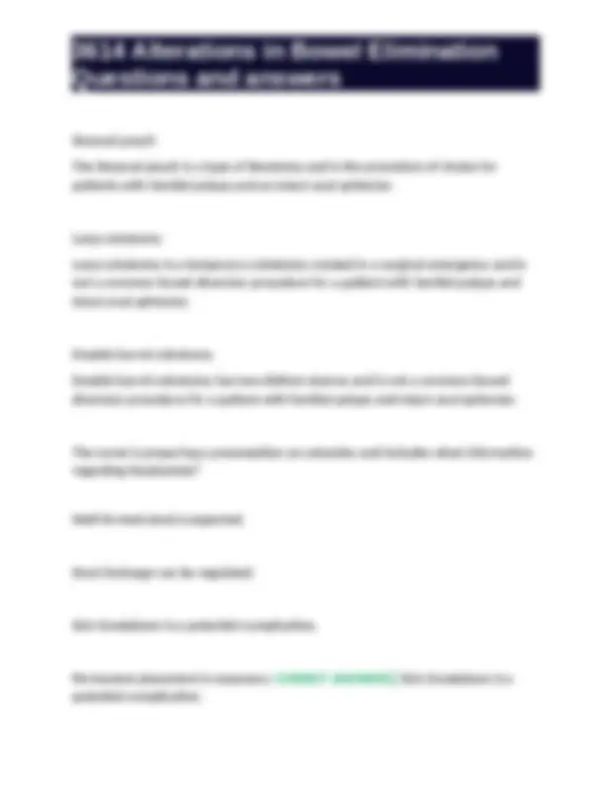

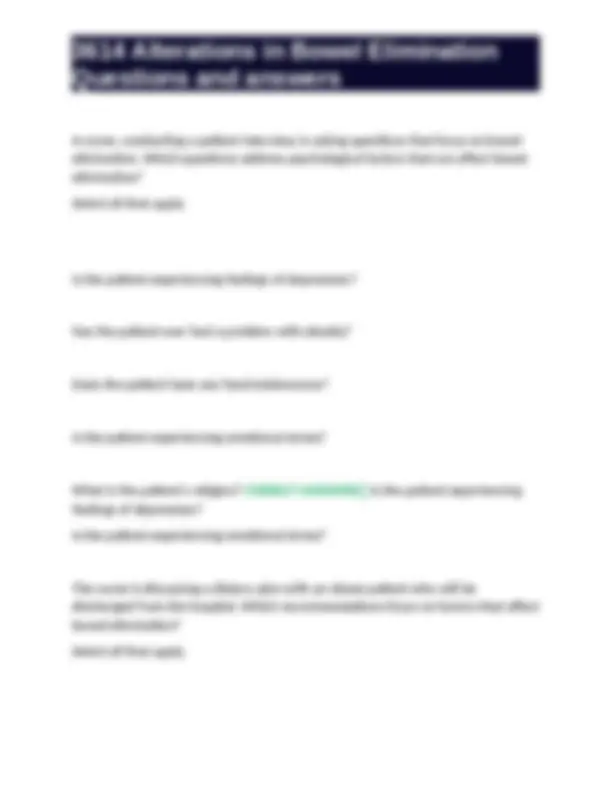

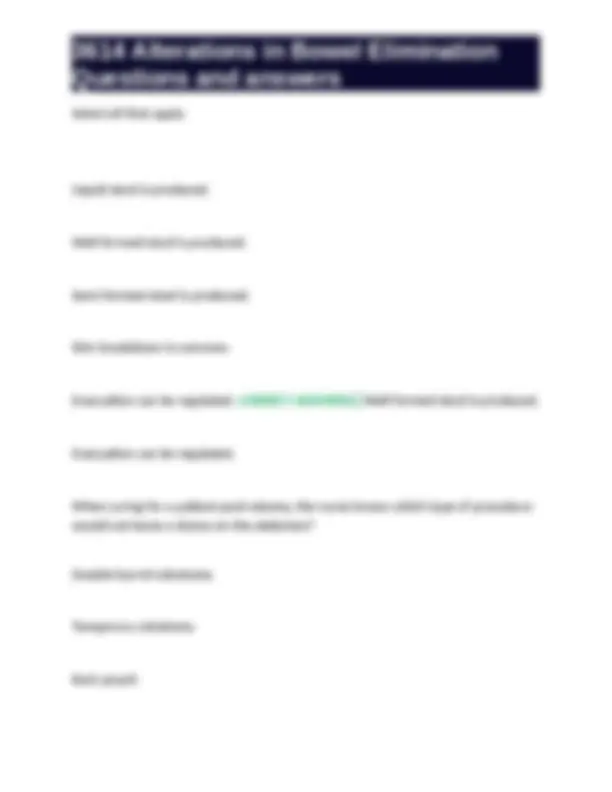
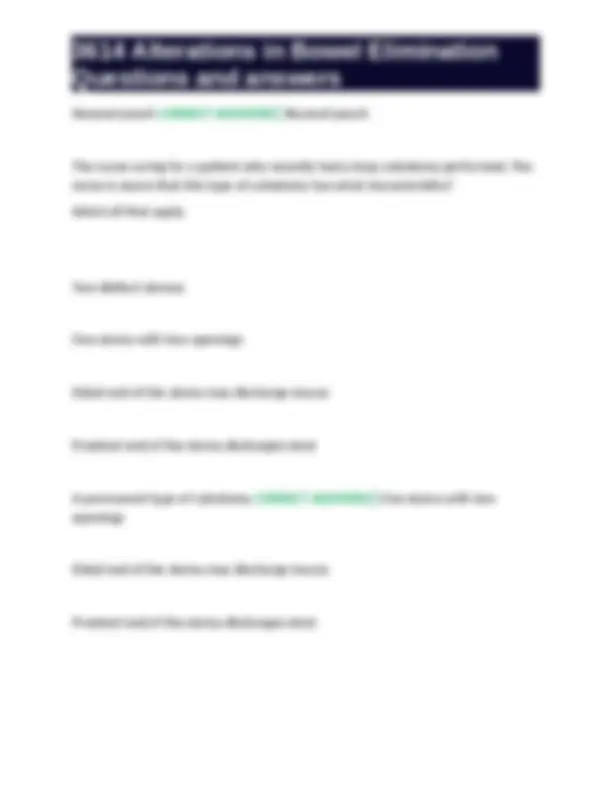
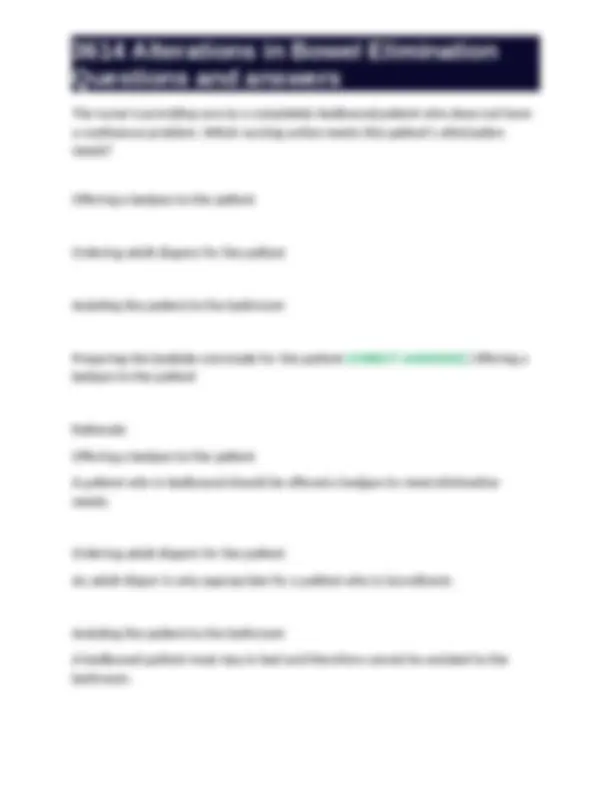
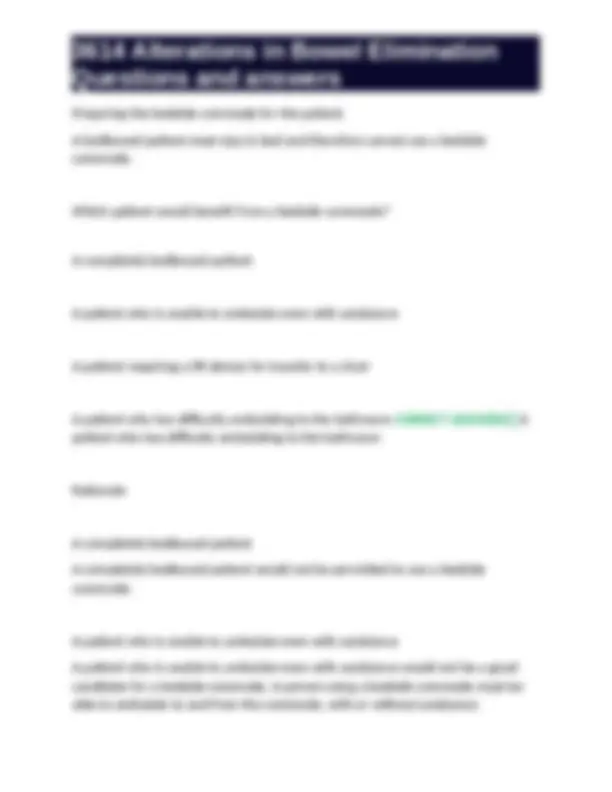
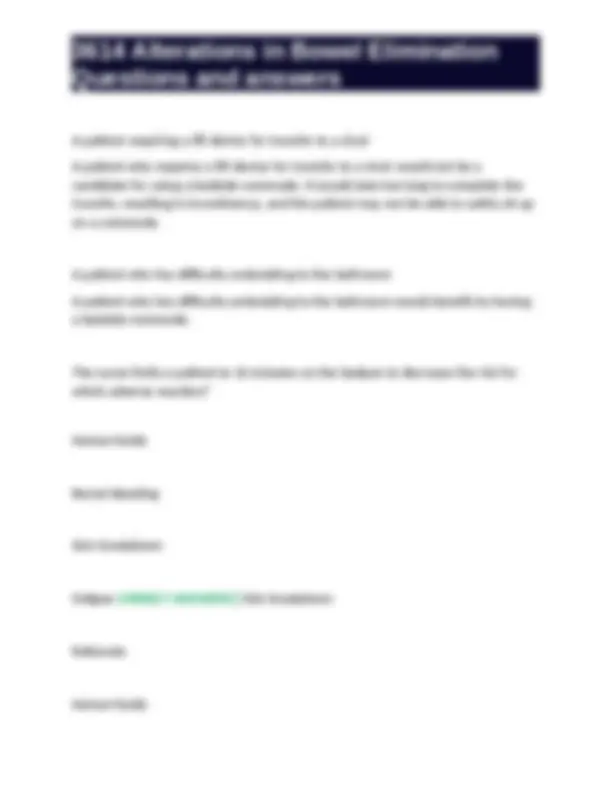
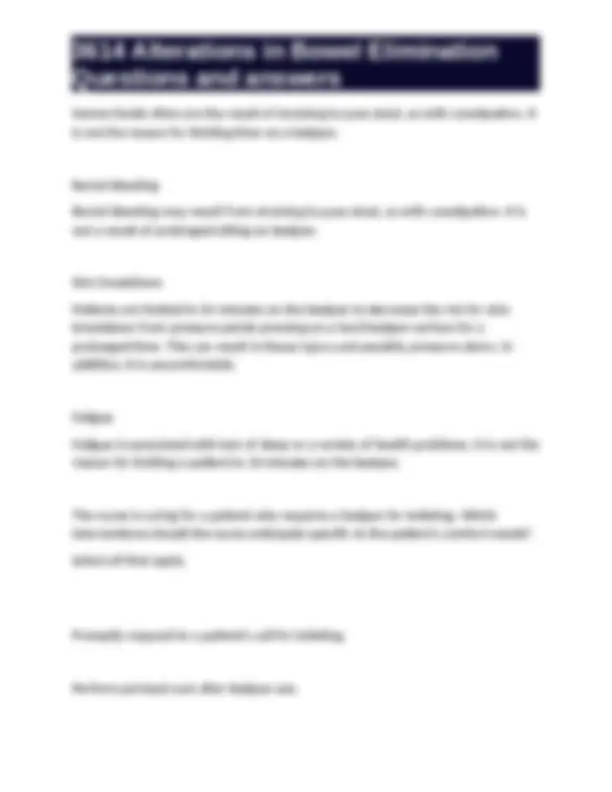
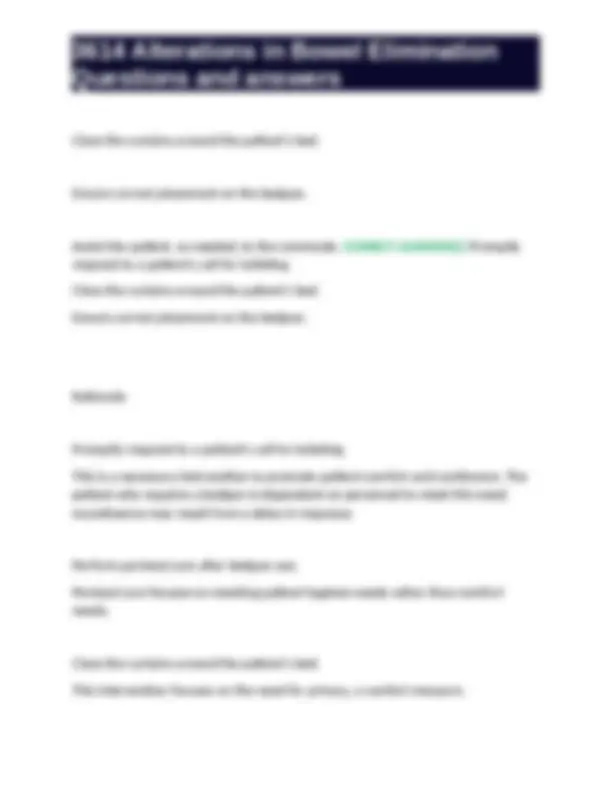
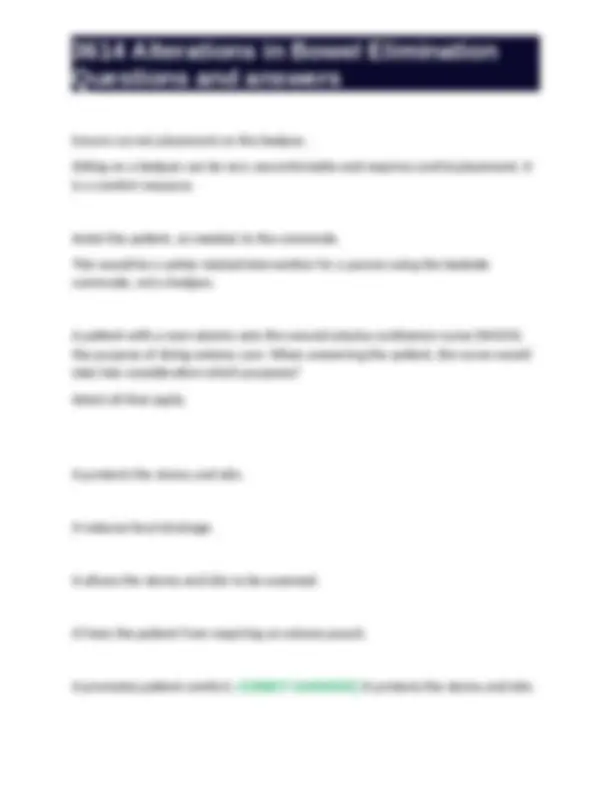
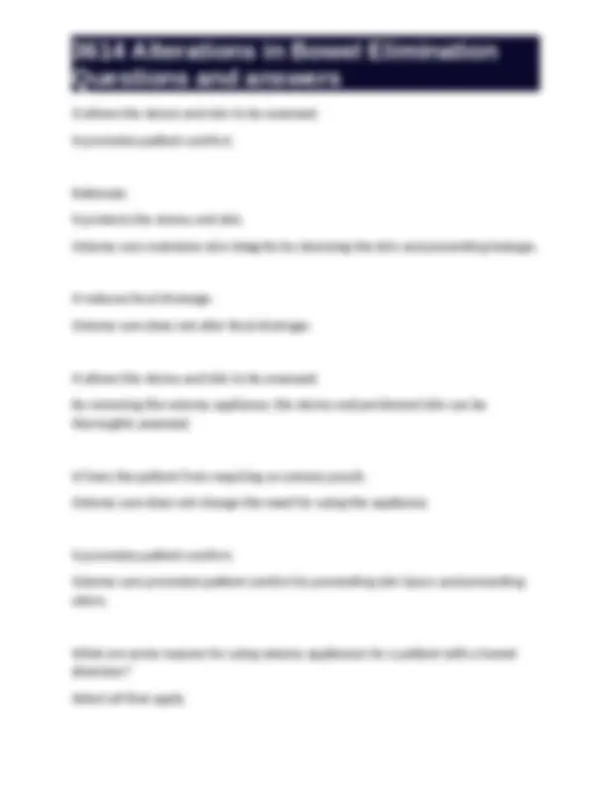
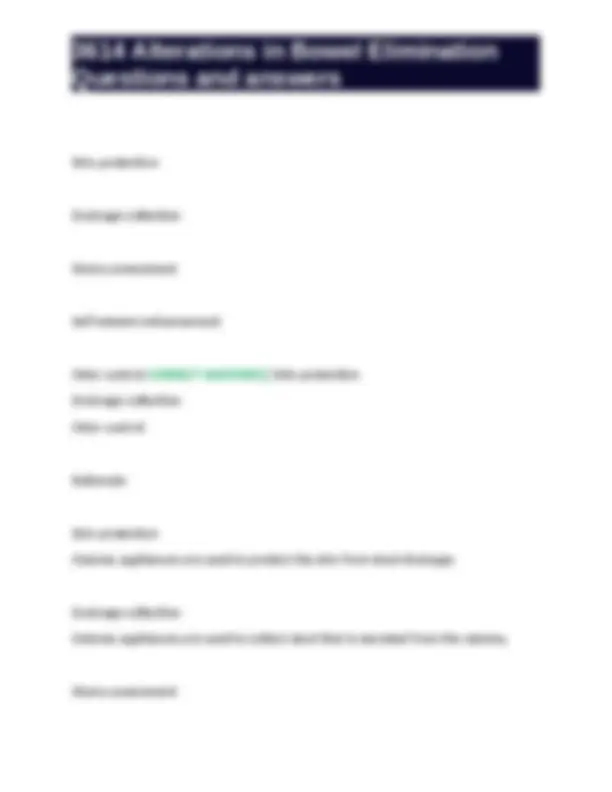
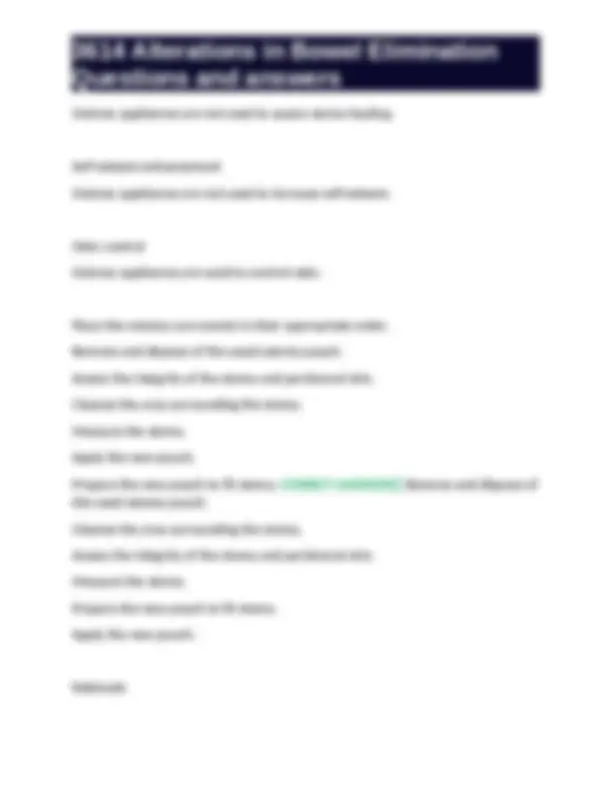
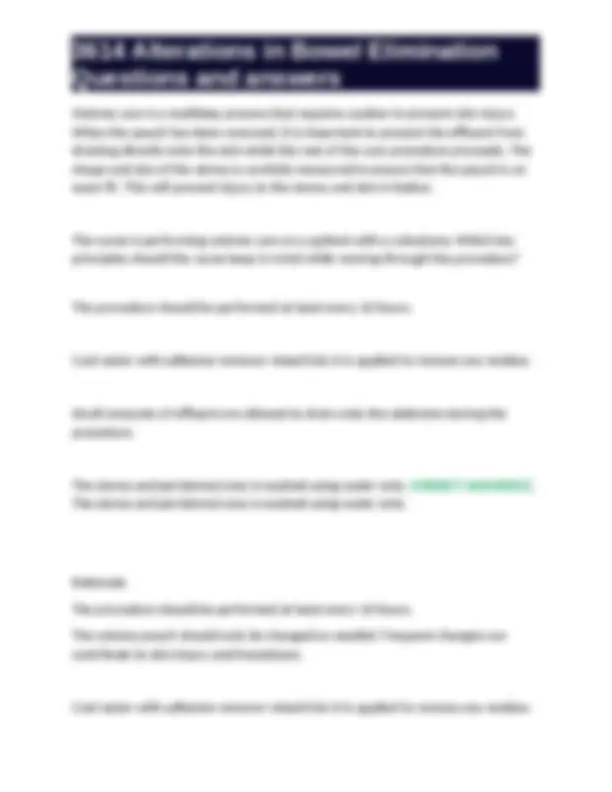
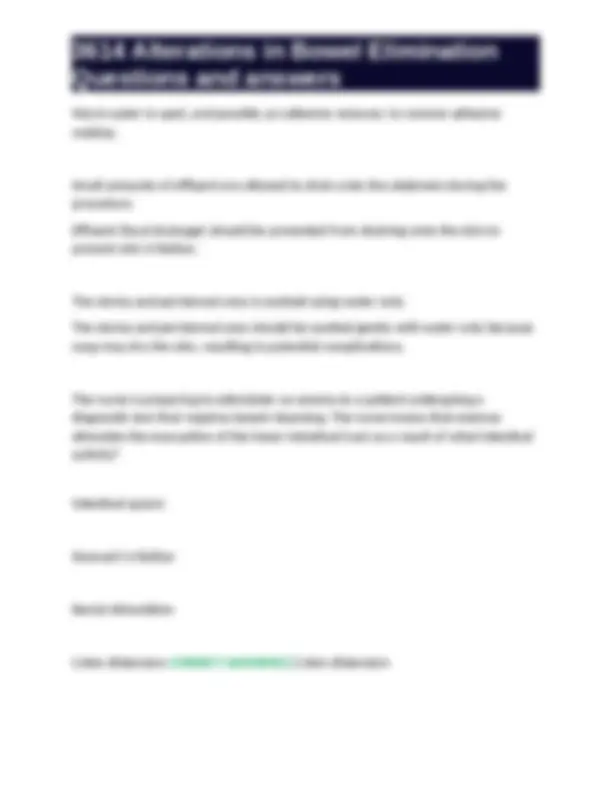
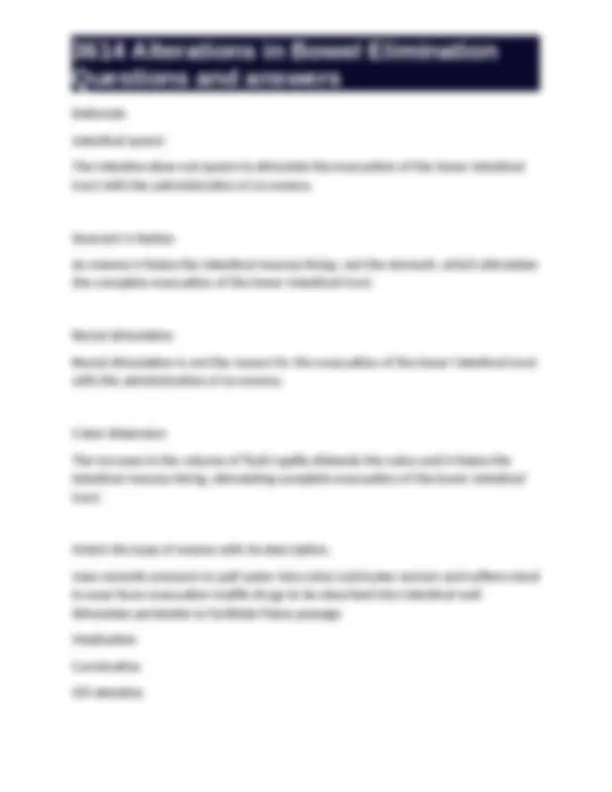
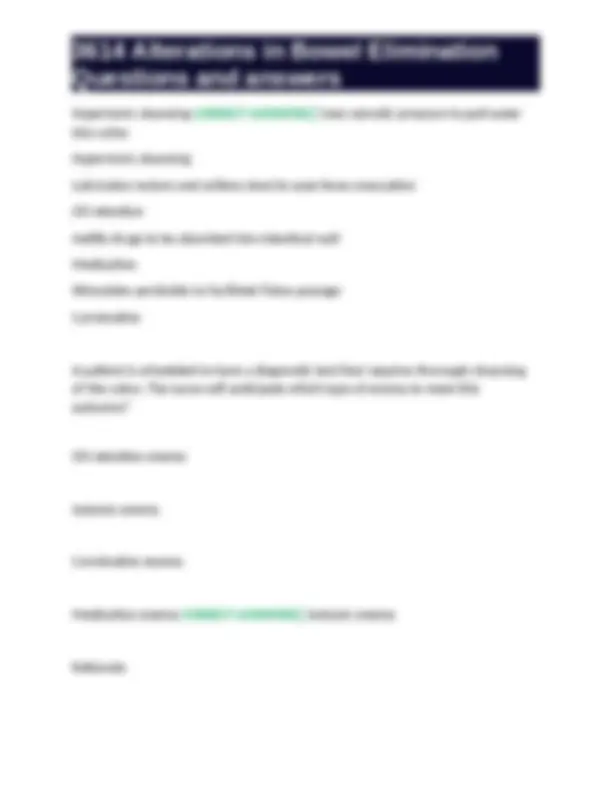
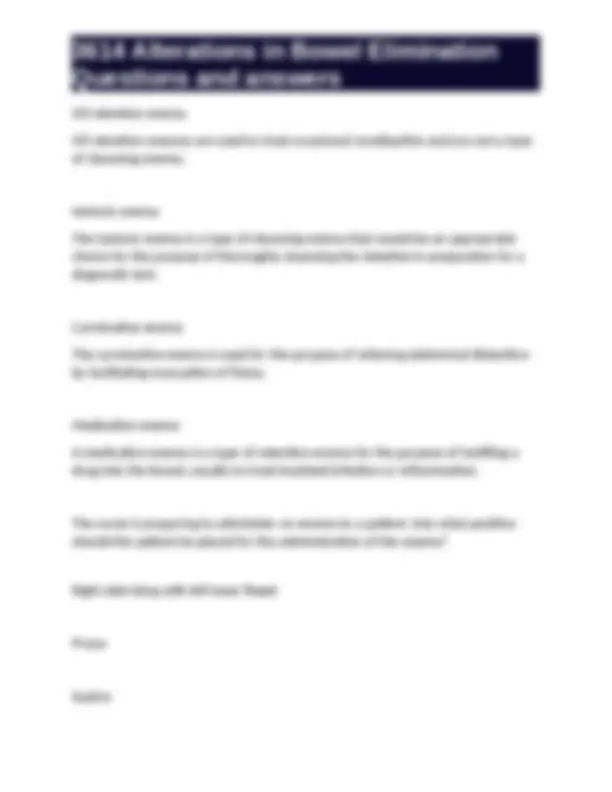
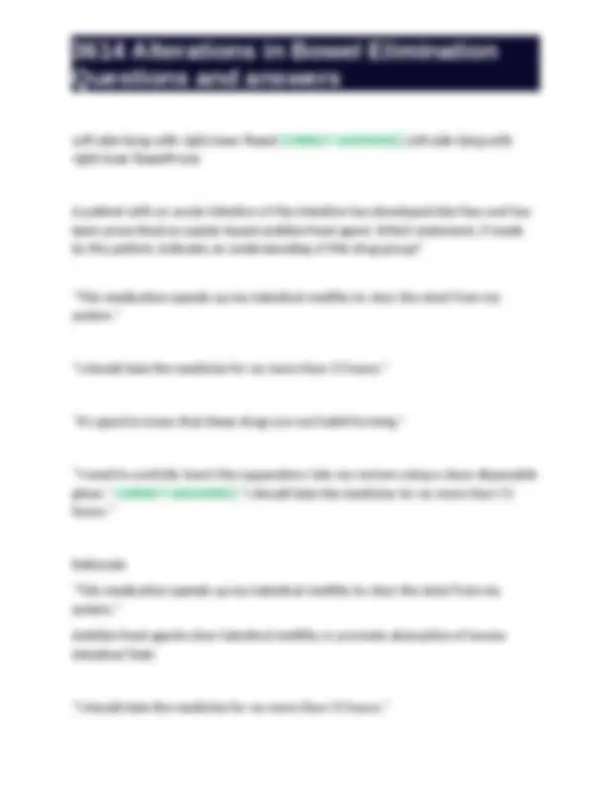
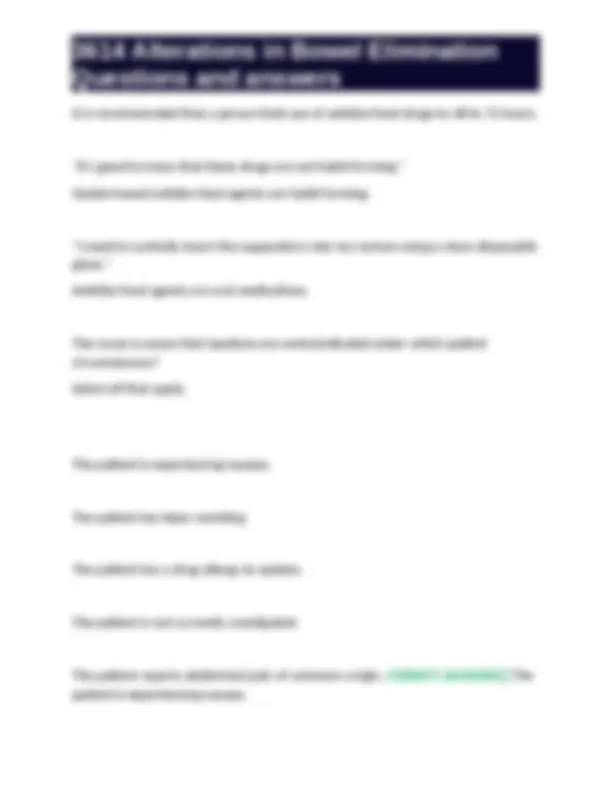
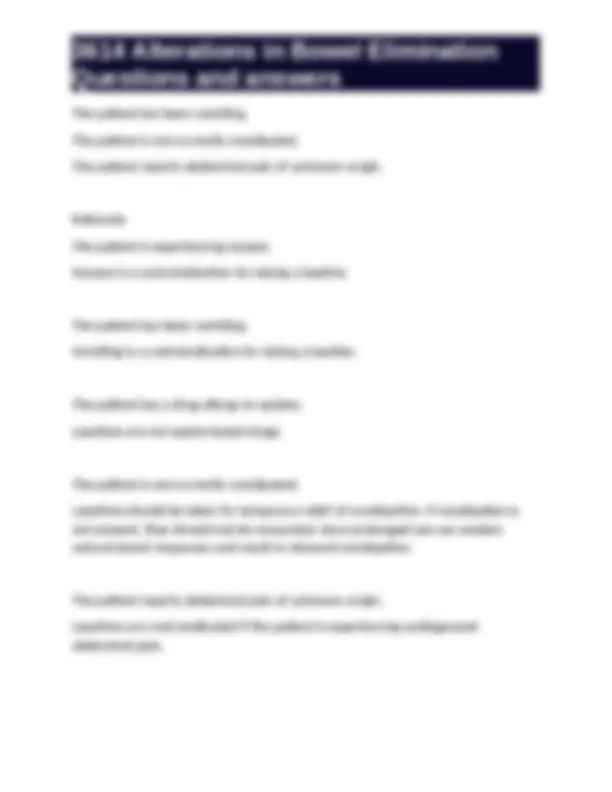

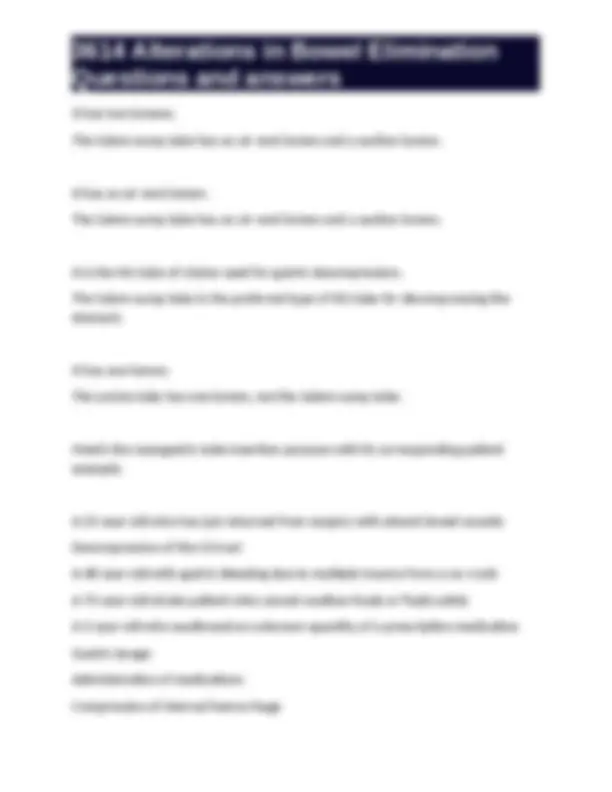
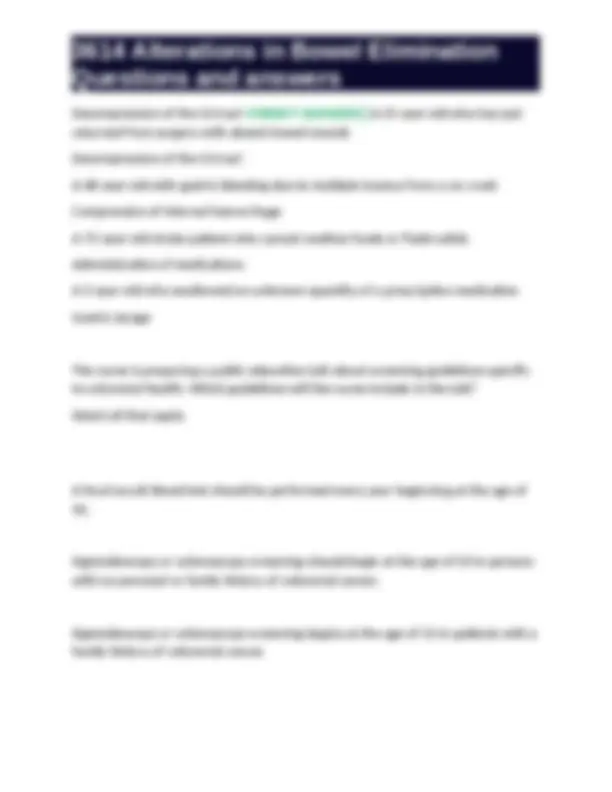
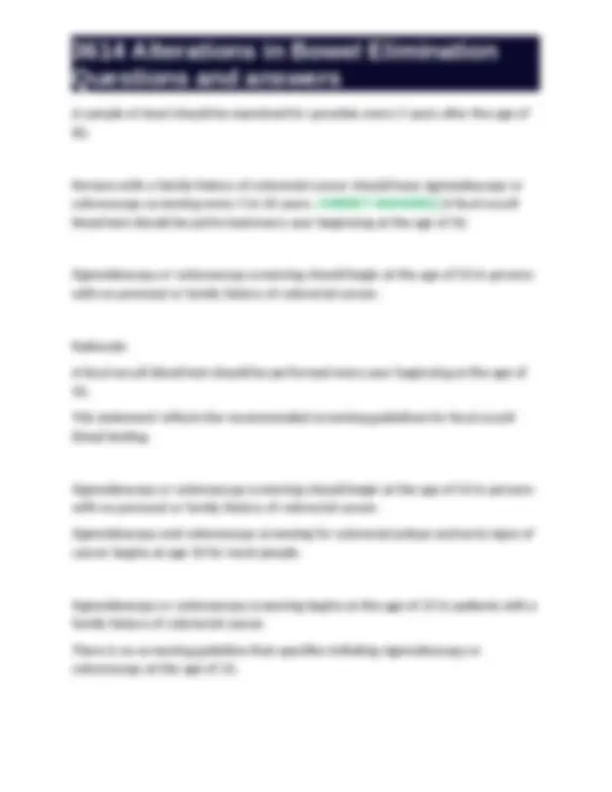
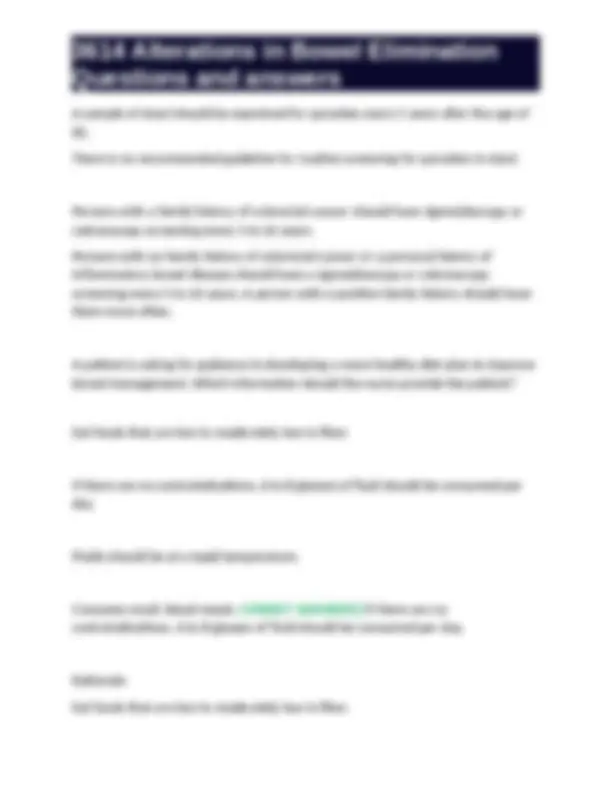
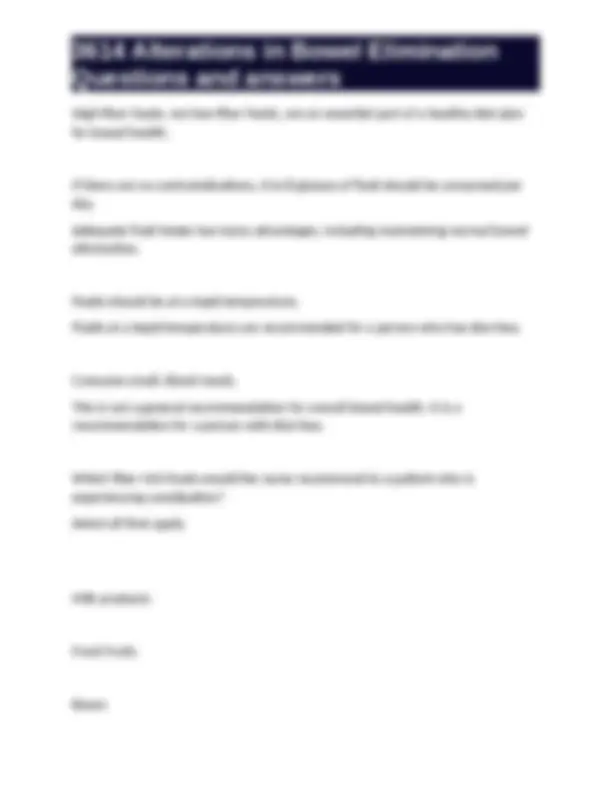
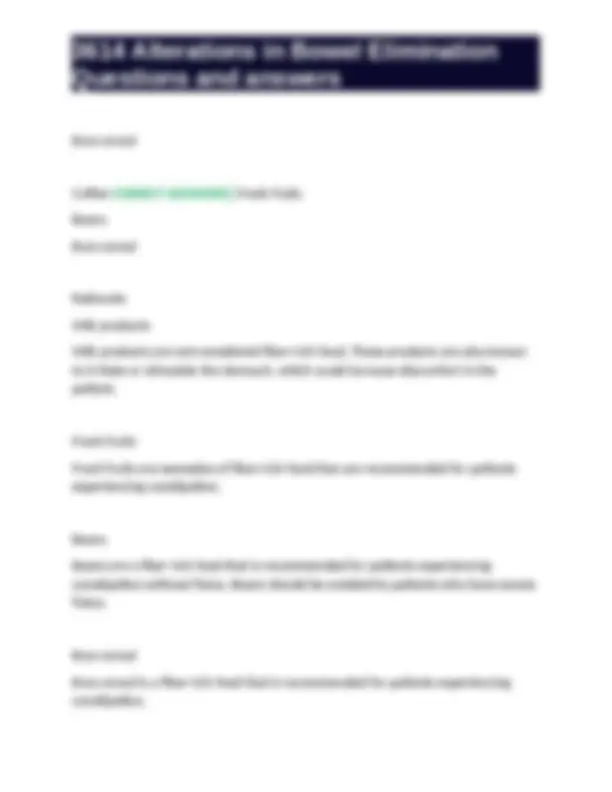
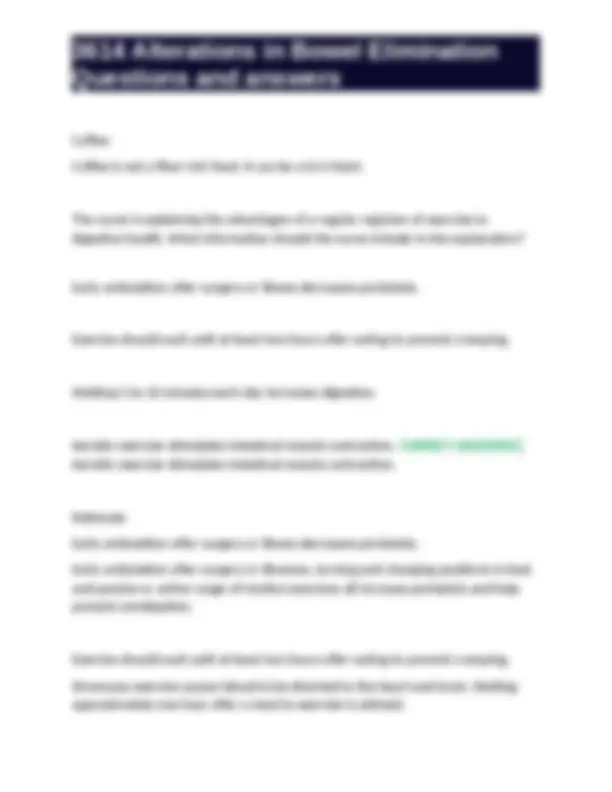
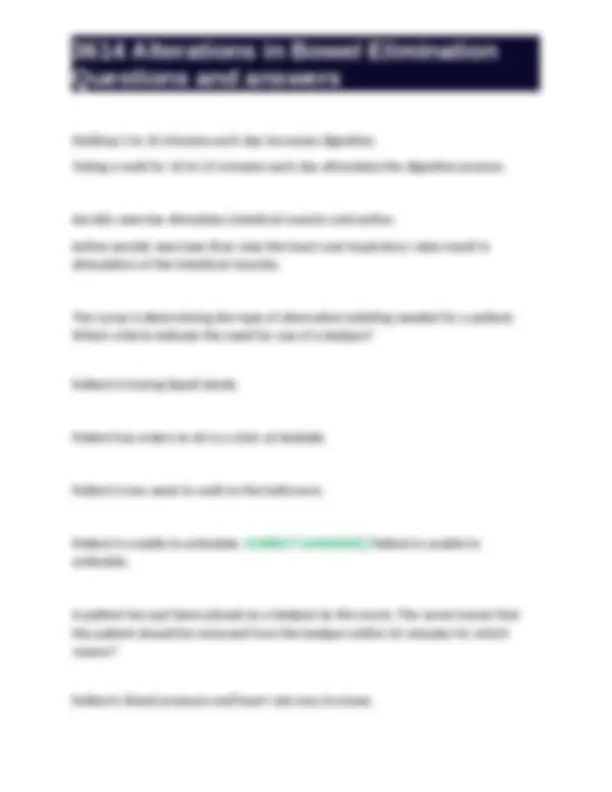
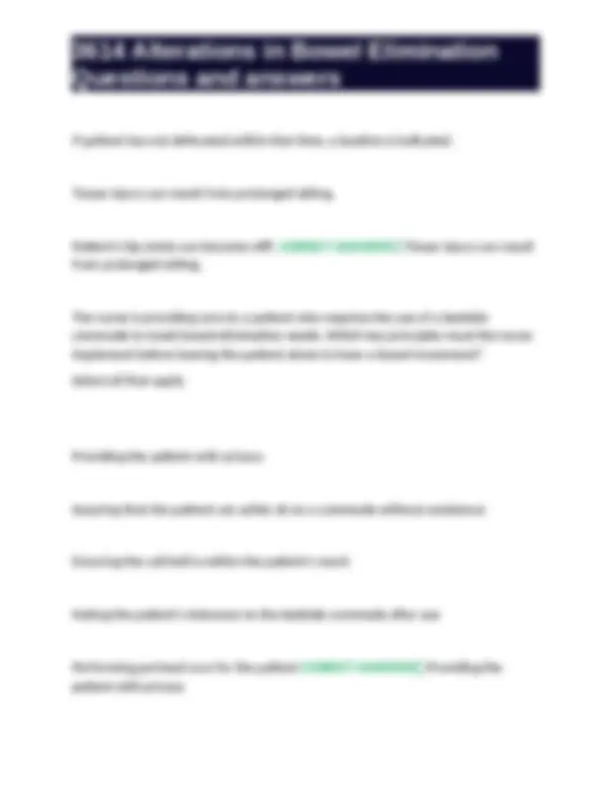
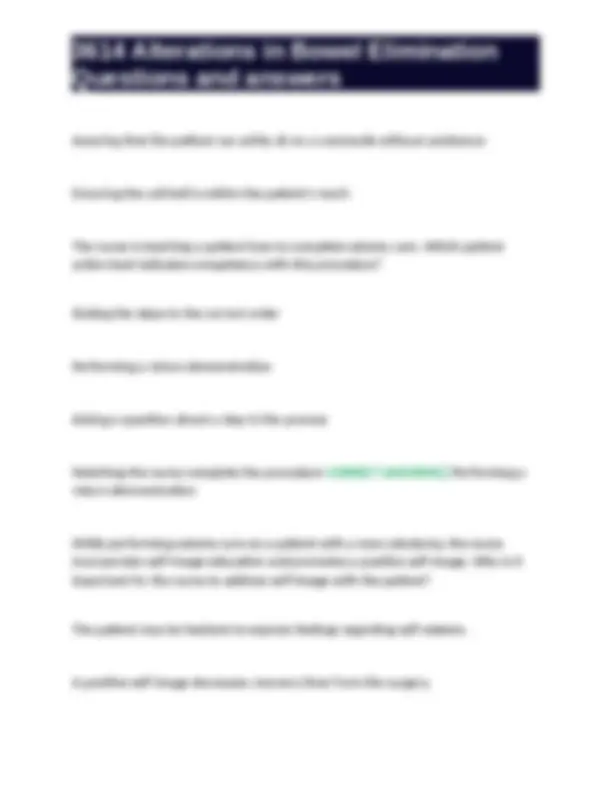
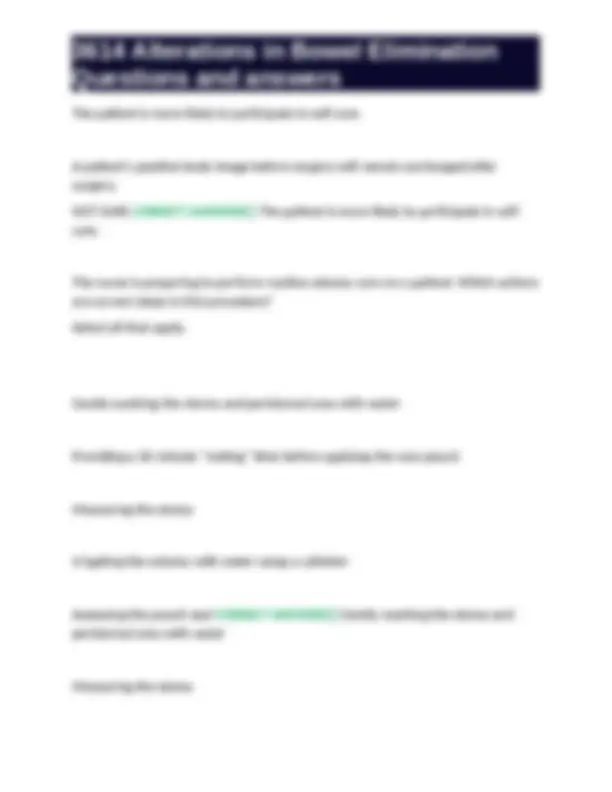


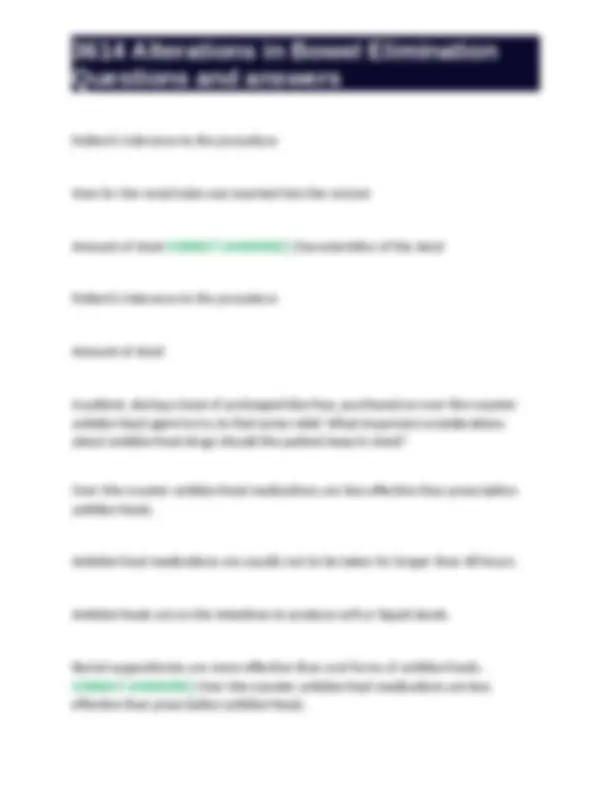
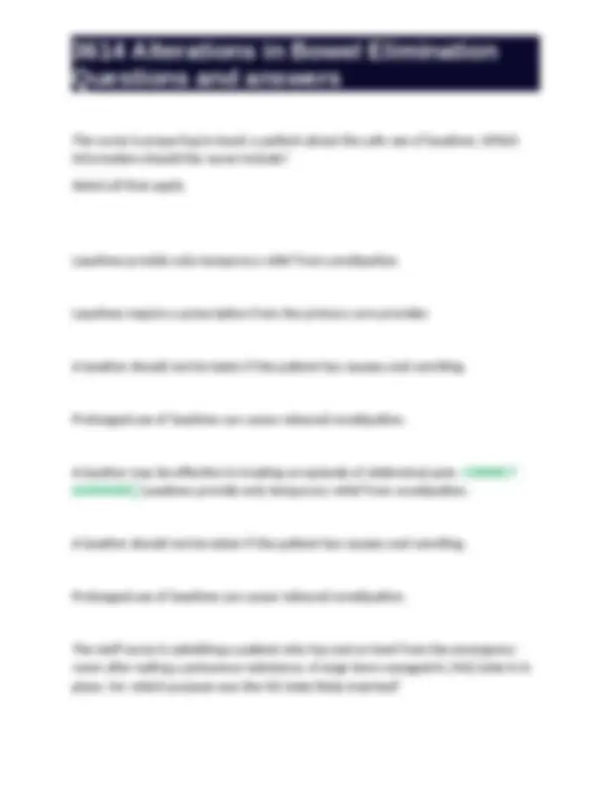

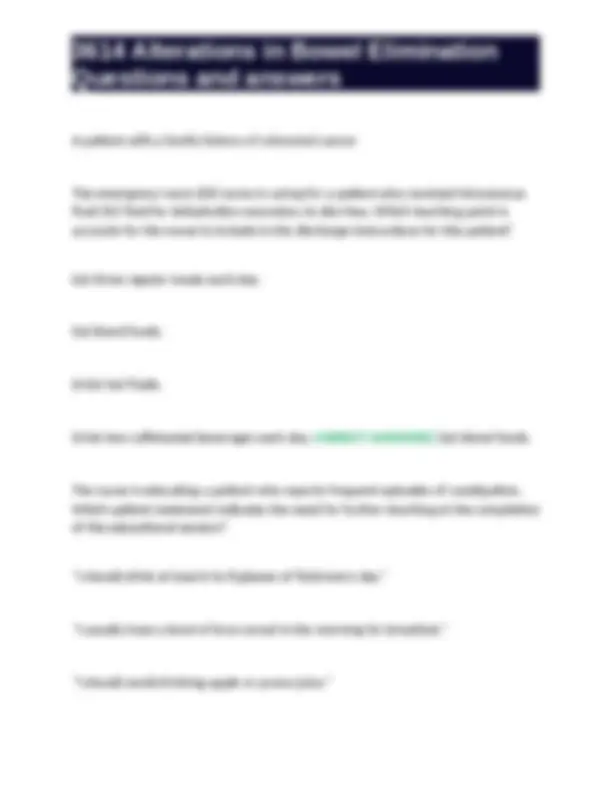

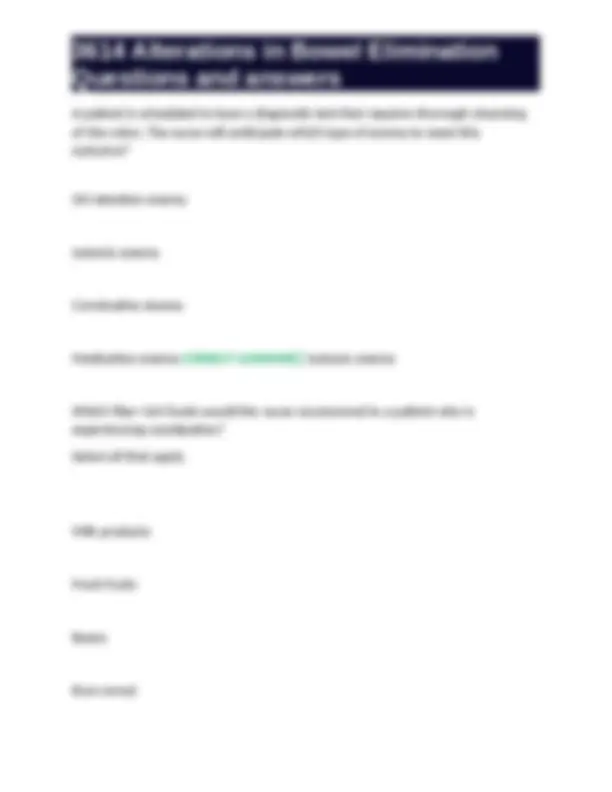
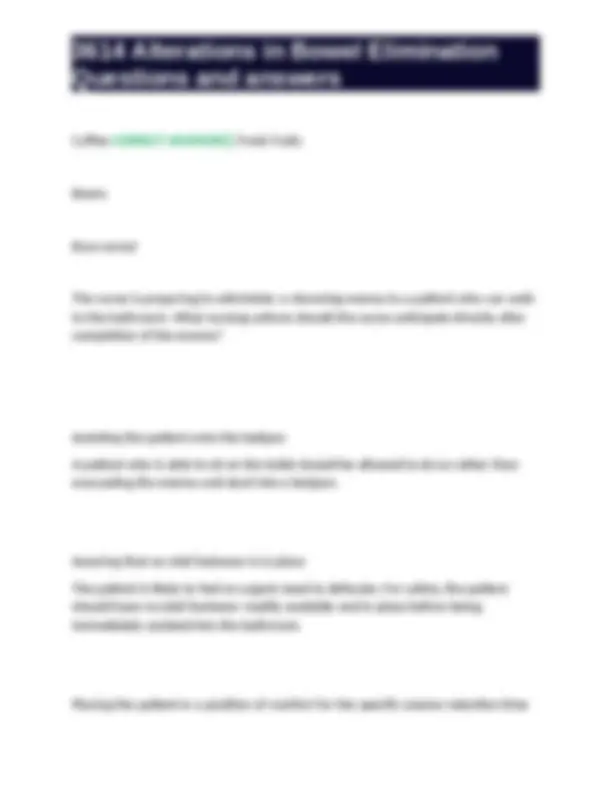
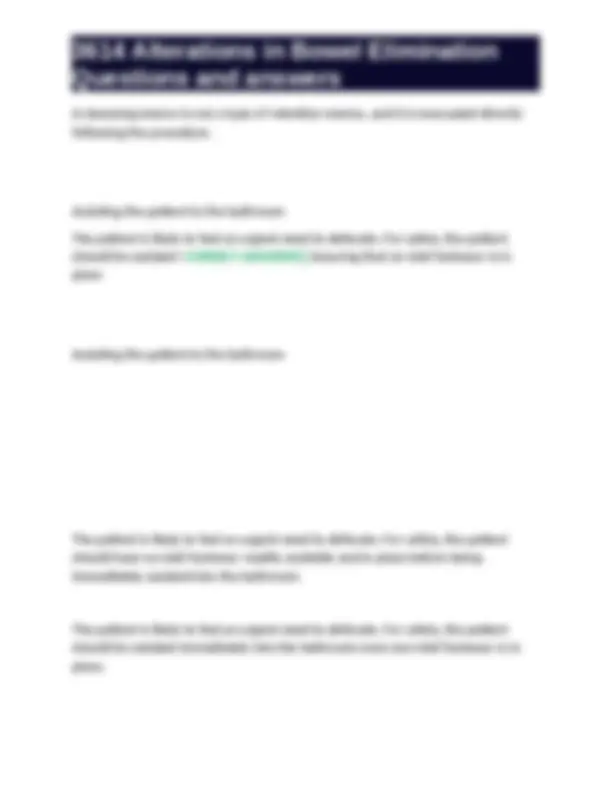
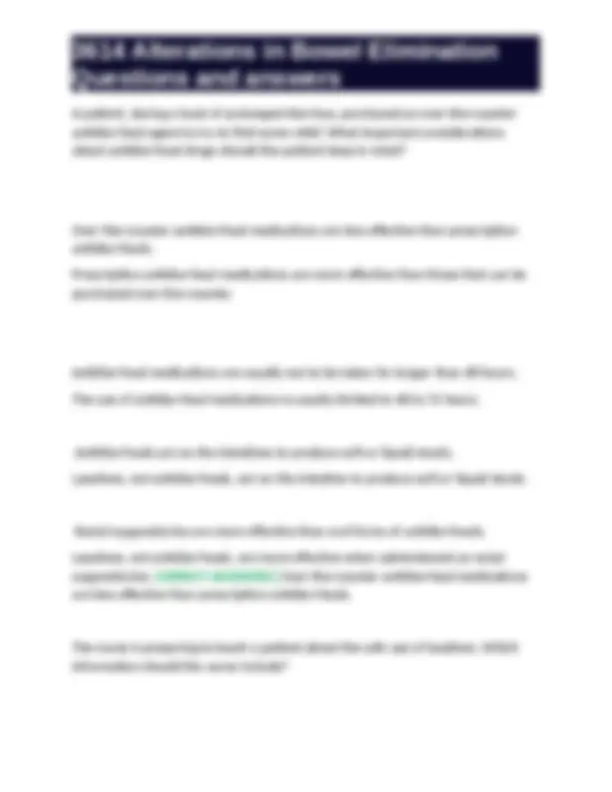
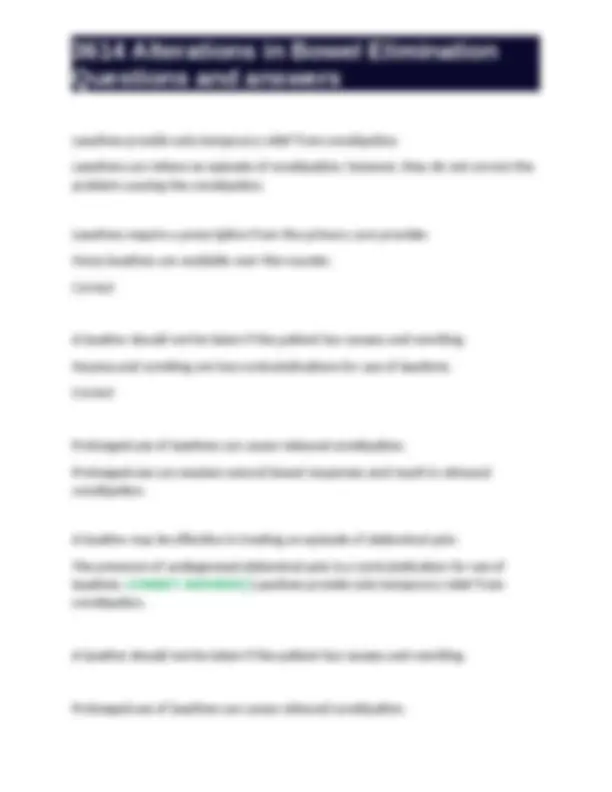


Study with the several resources on Docsity

Earn points by helping other students or get them with a premium plan


Prepare for your exams
Study with the several resources on Docsity

Earn points to download
Earn points by helping other students or get them with a premium plan
Community
Ask the community for help and clear up your study doubts
Discover the best universities in your country according to Docsity users
Free resources
Download our free guides on studying techniques, anxiety management strategies, and thesis advice from Docsity tutors
A comprehensive guide on alterations in bowel elimination, focusing on causes, potential complications, and care for hospitalized patients. It covers topics such as constipation, diarrhea, incontinence, and impaction, and offers answers to common questions related to these conditions. Particularly useful for nurses planning care for hospitalized patients, as it provides valuable insights into the management of bowel elimination issues.
Typology: Exams
1 / 62

This page cannot be seen from the preview
Don't miss anything!























































The nurse is aware that common alterations in bowel elimination patterns include which problems? Select all that apply. Diarrhea. Anorexia. Bowel incontinence. Constipation. Flatulence CORRECT ANSWERS✅ Diarrhea Bowel incontinence Constipation Rationale: Diarrhea Diarrhea is a common alteration in bowel elimination. Anorexia Anorexia is not an alteration in bowel elimination.
Bowel incontinence Bowel incontinence is a common alteration in bowel elimination. Constipation Constipation is a common alteration in bowel elimination. Flatulence Flatulence, the passing of flatus, is a normal part of GI function. Match each cause of altered bowel elimination to the type of alteration. Prolonged constipation Weakening of muscles in the rectum Too much water being absorbed by the intestine Not enough water being absorbed by the intestine Incontinence Diarrhea Impaction Constipation CORRECT ANSWERS✅ Prolonged constipation Impaction Weakening of muscles in the rectum Incontinence
Rationale: Stress Psychological stress can cause diarrhea. Inadequate liquid intake Inadequate liquid intake may cause constipation rather than diarrhea. Antibiotics Antibiotics can cause diarrhea. Enteral nutrition Receiving enteral nutrition (nutritional feedings delivered through a gastric or intestinal tube) can cause diarrhea. Hemorrhoids Hemorrhoids do not cause diarrhea. The nurse caring for a patient suffering from chronic constipation must be aware of which potential complication? Incontinence Diarrhea
Continence Impaction CORRECT ANSWERS✅ Impaction Rationale: Incontinence Incontinence is not a typical complication for patients with chronic constipation. Diarrhea Diarrhea is not a complication for patients with chronic constipation. Continence Continence is a normal defecation pattern, rather than a potential complication. Most patients with chronic constipation are continent of stool. Impaction Chronic constipation can lead to impaction. When planning care for a patient who does not recognize the urge to defecate, what is a potential bowel elimination concern that the nurse should take into consideration? Select all that apply.
Bowel incontinence Bowel incontinence can result when a patient fails to recognize the urge to defecate. Flatulence Flatulence is a normal occurrence in the GI tract and is not a concern specific to failure to recognize the urge to defecate. The nurse knows that an adult should have an intake of approximately how many ounces of fluid daily? 8 16 32 64 CORRECT ANSWERS✅ 64 Rationale: 8 Significantly, adults require more fluid intake to avoid chronic constipation. 16 Adults should consume significantly more fluid daily to avoid constipation.
32 This is approximately half of the amount of fluid an adult should consume daily. 64 An adult should consume approximately 64 ounces of fluid daily. A nurse caring for an obese person understands the increased risk for which complication of bowel function? Hemorrhoid formation Poor nutrient absorption Decreased food intake Diarrhea CORRECT ANSWERS✅ Hemorrhoid formation Rationale: Hemorrhoid formation Due to the higher risk for developing constipation and straining to have a bowel movement, the incidence of hemorrhoids increases for obese individuals. Poor nutrient absorption Obesity itself does not cause poor nutrient absorption. Decreased food intake
Select all that apply. Pregnancy High blood pressure Narcotic pain medication Urinary catheterization Decreased mobility CORRECT ANSWERS✅ Pregnancy Narcotic pain medication Decreased mobility Rationale: Pregnancy Several issues during pregnancy can affect bowel elimination. High blood pressure This is not a contributing factor to the alteration in bowel elimination.
Narcotic pain medication This is a contributing factor to the alteration in bowel elimination. Urinary catheterization This is a not a contributing factor to the alteration in bowel elimination. Decreased mobility This is a contributing factor to the alteration in bowel elimination. When discussing ostomy care with a patient before surgery, what does the nurse explain is the main factor determining the stool consistency? Fluid intake Laxative use Dietary fiber Anatomical location CORRECT ANSWERS✅ Anatomical function Rationale: Fluid intake
Right side of abdomen Transverse colostomy Upper middle to right of abdomen Descending colostomy Upper left quadrant Sigmoid colostomy Lower left quadrant A patient with familial polyps and intact anal sphincter is scheduled for a bowel diversion procedure. The nurse knows this patient will most likely undergo which bowel diversion procedure? Kock pouch Ileoanal pouch Loop colostomy Double-barrel colostomy CORRECT ANSWERS✅ Ileoanal pouch Rationale: Kock pouch Kock pouch is an alternative to ileostomy and is not a common bowel diversion procedure for a patient with familial polyps and intact anal sphincter.
Ileoanal pouch The Ileoanal pouch is a type of ileostomy and is the procedure of choice for patients with familial polyps and an intact anal sphincter. Loop colostomy Loop colostomy is a temporary colostomy created in a surgical emergency and is not a common bowel diversion procedure for a patient with familial polyps and intact anal sphincter. Double-barrel colostomy Double-barrel colostomy has two distinct stomas and is not a common bowel diversion procedure for a patient with familial polyps and intact anal sphincter. The nurse is preparing a presentation on ostomies and includes what information regarding ileostomies? Well-formed stool is expected. Stool drainage can be regulated. Skin breakdown is a potential complication. Permanent placement is necessary. CORRECT ANSWERS✅ Skin breakdown is a potential complication.
Psychological stress Clostridium difficile CORRECT ANSWERS✅ Clostridium difficile An unconscious patient has begun enteral feedings. This places the patient at increased risk for which defecation pattern alteration? Constipation Continence Loose stools Impaction CORRECT ANSWERS✅ Loose stools A patient has a history of chronic constipation. The nurse knows this can lead to which alterations? Select all that apply. Clostridium difficile Hemorrhoids
Stool incontinence Impaction Diarrhea CORRECT ANSWERS✅ Hemorrhoids Impaction The nurse knows that patients may experience which potential response to sharing a bathroom? Select all that apply. Constipation Diarrhea Stool incontinence Embarrassment Continence CORRECT ANSWERS✅ Constipation Embarrassment
Follow a high-fiber diet. Follow a low carbohydrate diet. Increase consumption of spicy foods. Drink plenty of fluids. Increase physical activity. CORRECT ANSWERS✅ Follow a high-fiber diet. Drink plenty of fluids. When caring for a patient on antibiotic therapy, the nurse identifies which abnormal assessment finding as most likely the result of antibiotic therapy? Blood in the stool Constipation Diarrhea Impaction CORRECT ANSWERS✅ Diarrhea The nurse is caring for a patient with a new sigmoid colostomy and prepares supplies for drainage of stool with what characteristics?
Select all that apply. Liquid stool is produced. Well-formed stool is produced. Semi-formed stool is produced. Skin breakdown is common. Evacuation can be regulated. CORRECT ANSWERS✅ Well-formed stool is produced. Evacuation can be regulated. When caring for a patient post-ostomy, the nurse knows which type of procedure would not leave a stoma on the abdomen? Double-barrel colostomy Temporary colostomy Kock pouch